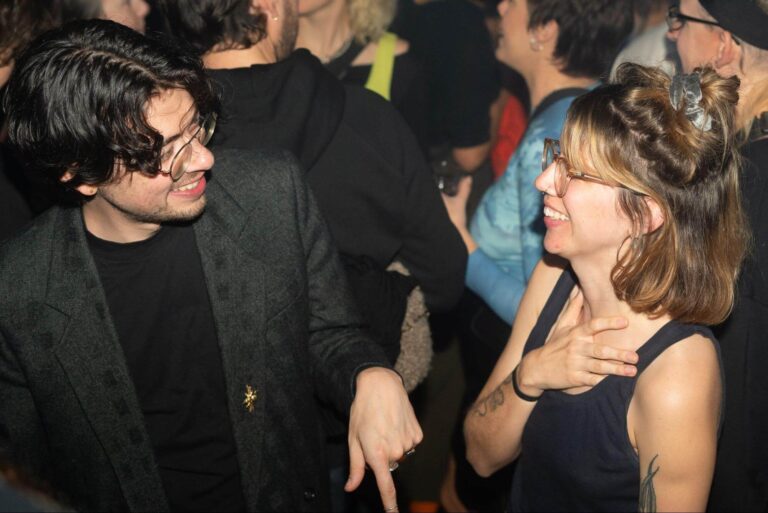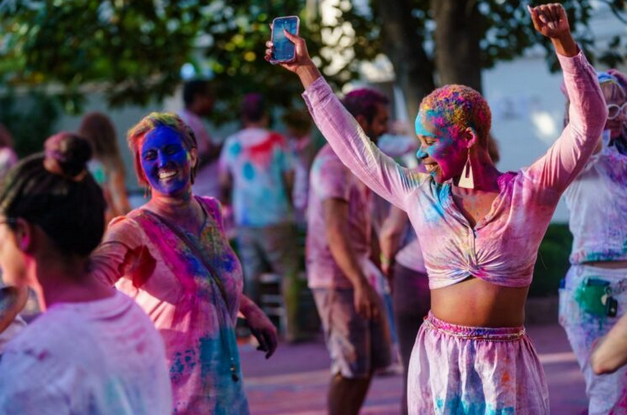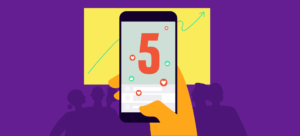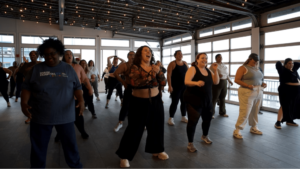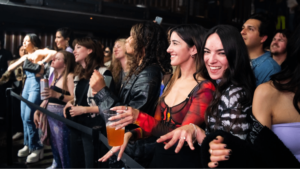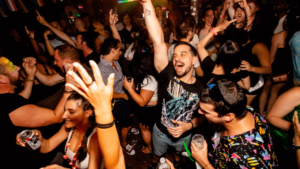It’s 2025, y’all, and we’ve heard it all before. You don't need me to tell you to “share live photos!” or “post regularly!” to promote your events on social media.
What you need is a strategy — one that’s going to help you get your brand in front of the right people, build a loyal following, and convince said people to buy tickets to your events.
Not just once but time after time (Cyndi Lauper knows what I mean).
The good news? Your audience is on social media, and they want to find you (I promise). In our TRNDS 2025 report, we found:
- Approx 61% of Millennials use social media to find things to do
- Almost 30% of Gen Z use TikTok specifically for event discovery
- Nearly 24% of attendees discover events by following people with similar interests
All you need to do is figure out how to ensure it’s your event brand people see when they search for fun things to do — and then speak directly to what they want.
To help you do that, I’m sharing wisdom from Natasha Fuentes and Sophie Vershbow, two fabulous experts from our Eventbrite social media and influencer marketing team. They weighed in on what’s working (and what’s not) in social media event marketing.
Here’s a complete rundown of what you need to do.
1. Find the “ideal platforms” for your event brand
I always thought the key to social media marketing was simply finding out which platforms where the majority of users match your target demographic and meeting them there. But Sophie pointed out that there is much more to it than that, "...there are different ideal platforms for different creators."
Sure, certain social platforms attract specific audiences, but success isn't just about being there — it's about how you show up and what you’re doing to match user expectations.
To give you a better idea, let's look at each social platform and what type of content works best.
| Social network | Summary | Usage by gender | Usage by age | Pro tip to “getting it right” |
| Ideal for sharing event updates, engaging followers, and creating event pages. | 53.5% women 46.2% men | 18.6% 18-24 year olds 24.2% 25-34 year olds 19% 35-44 year olds 14.2% 45-54 year olds 11.7% 55-64 year olds 12.3% 65+ year olds | Keep it simple. Post often, but time it right! | |
| TikTok | Great for short-form content, but is also being used as a search engine to find fun things to do. | 55.7% men 44.3% women | 25% 18-24 year olds 30% 25-34 year olds 19% 35-44 year olds 13% 45-54 year olds 14% 55+ year olds | Make sure you participate in trending challenges, use trending sounds, and include viral hashtags to get your content noticed. |
| Perfect for posting live event photos and engaging with your community. | 50.1% men 46.2% women | 31.7% 18-24 year olds 30.6% 25-34 year olds 16% 35-44 year olds 8.7% 45-54 year olds 4.6% 55-64 year olds 2.9% 65+ year olds | Engage with your followers! Show your followers some love by responding to comments, liking their posts, and replying to direct messages. | |
| YouTube | Top platform when it comes to long-form content like vlogs, behind-the-scenes shoots, live-streaming, music drops, and reaction/review videos. | 54% men 46% women | 15.5% 18-24 year olds 21.3% 25-34 year olds 17.5% 35-44 year olds 12.5% 45-54 year olds 9.2% 55-64 year olds 9.2% 65+ year olds | High-quality storytelling “deep dive” reporter-style videos, and collaborations with other YouTubers are your best bet. |
| Go-to for business-to-business connections and professional networking. | 57% men 43% women | 24.5% 18-24 year olds 50.6% 25-34 year olds 21.2% 35-54 year olds 3.8% 55+ year olds | Audiences tend to value longer-form, helpful content. Think of a guide where you can give your audience advice on a problem they often face. | |
| X | Great place to post funny content that sparks conversations and engages your audience in real-time debates. | 60.9% men 39.1% women | 34.2% 18-24 year olds 36.6% 25-34 year olds 19.7% 35-49 year olds 7% 50+ year olds | Keep things short, sweet, and sometimes quirky. |
Facebook is ideal for sharing event updates, engaging followers, and creating event pages.
- Leading demographic: Younger audiences are still Facebook’s number one audience, with 25-34-year-olds making up 24.2% of users.
- What works: Natasha’s suggestion? Keep it simple: “Post often, but time it right! Get your audience talking with polls, quizzes, and live videos. These interactive posts let people share their thoughts in real-time and feel more connected — perfect for sparking conversations and building a lively community!”
- Example: Centered Healing uses Facebook to create individual event pages for their wellness workshops and healing sessions.
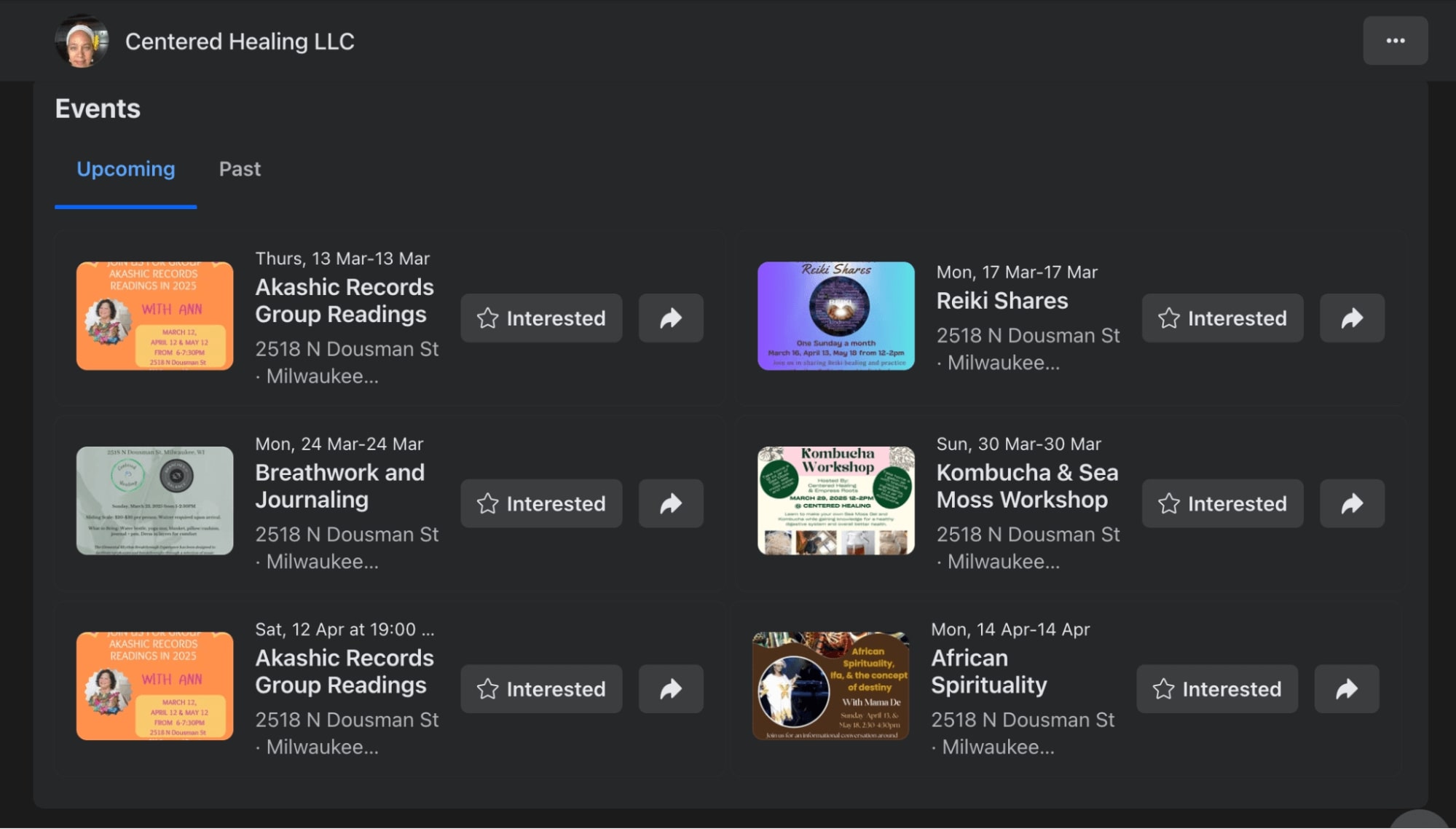
TikTok
We’ve said it once (and I’ll say it again): TikTok is the epicenter of short, form creative content.
Influencer Pia Blossom puts it best in our TRNDS report 2025:
TikTok is amazing for its ability to surface content that resonates with your interests and values — even if you weren’t actively looking for it. It’s like a digital word-of-mouth, making it easy to discover meaningful experiences you might not have known about otherwise.
But in 2025, TikTok isn’t just for scrolling your FYP — it’s a search engine. 2 out of 5 Americans use TikTok to search and 10% of Gen Z’ers would choose it over Google.
- Leading demographic: Sophie was right when she told us that “TikTok and YouTube are the biggest Gen Z platforms.” As of 2025, 25-34-year-olds make up 30% of TikTok’s audience, closely followed by 18-24-year-olds at 25%.
- What works: Natasha explained that TikTok is all about trends. “Make sure you participate in trending challenges, use trending sounds, and include viral hashtags to get your content noticed. Make sure to add your own twist to it to capture the audience’s attention.”
- Example: Too Chillz uses trending sounds on TikTok to showcase the unique vibe of their events.
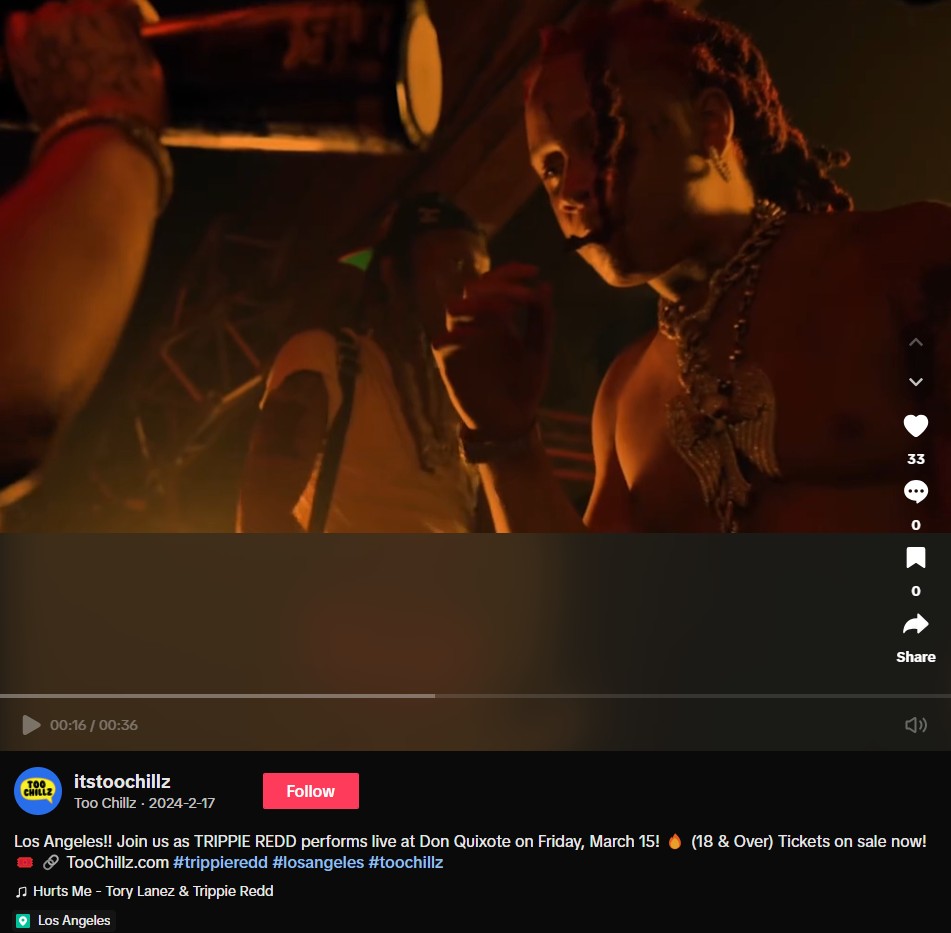
If TikTok is the fun (albeit slightly chaotic) little sister, Instagram is the perfectly put-together cousin who’s always “living her best life.” Insta is still where we head when we want to be inspired by others, or to post a pic that makes our lives look a little more *aesthetic*.
- Leading demographic: 18-24-year-olds take the lead on Insta, making up 31.7% of users.
- What works: You want to make sure the experience feels personal. “Engage with your followers! Show your followers some love by responding to comments, liking their posts, and replying to direct messages. Building those connections sparks even more interaction on your posts!”
- Example: FoodieLand floods their Insta page with colorful food pics to give potential attendees a taste (wink) of what to expect at their events.
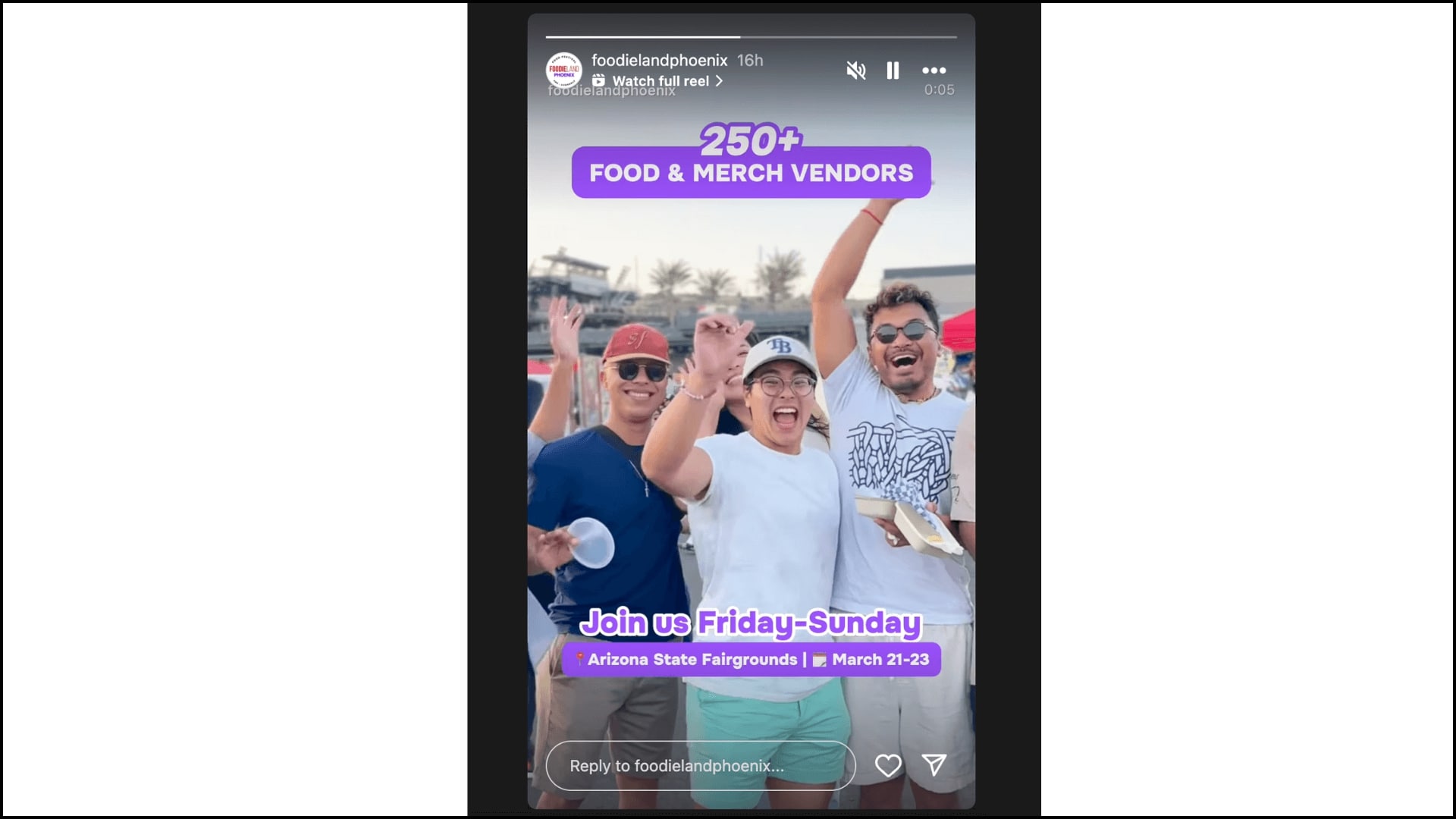
YouTube
YouTube is king when it comes to long-form content (it’s kinda where the whole “influencer-who-is-actually-your-bestie” idea was born). People still use “the Tube” to find relatable and useful content, like vlogs, behind-the-scenes shoots, live-streaming, music drops, and reaction/review videos.
- Leading demographic: This is another key platform for reaching Gen Z audiences under 25, with 12% of YouTube’s audience coming from men between 25-34 and 10.1% of women in the same age bracket.
- What works: High-quality storytelling, music content (such as livestreams of live shows), “deep dive” reporter-style videos, and collaborations with other YouTubers are your best bet.
- Example: House of Yes is building a YouTube following with their new “Breakfast With Boyyyish” livestream series.
LinkedIn is the go-to for business-to-business connections and professional networking. Your content can be promotional… as long as it’s also genuinely useful. It’s like the Facebook of the business world — you’re there to connect, but with a purpose.
- Leading demographic: 25-34-year-olds are dominating LinkedIn, making up 50.6% of the platform's total users.
- What works: Go for a more professional tone. That doesn’t mean you have to be humorless, but the audience there tends to value longer-form, helpful content. Think of a guide where you can give your audience advice on a problem they often face.
- Example: Los Angeles Business Journal uses LinkedIn to share updates on their conferences, industry events, and business news.

X
Y’all remember when Twitter (sorry, I mean “X”) used to be the place for political debates, and “here’s my weird 3 AM thought” posts? Sigh. Me too.
While X isn’t quite what it used to be (the platform lost 2.6 million users in just two months back in 2024), it’s still a great place to post funny content that sparks conversations and engages your audience in real-time debates.
- Leading demographic: There’s a more even split between Gen Z and Millennials on X, with 25-34-year-old men making up 22.4% of users, followed closely by men aged 18-24.
- What works: Keep things short, sweet, and sometimes quirky. For example, tell a joke or give a brief anecdote to which your audience can relate.
- Example: Bob Baker Marionette Theatre posts about upcoming events and shares behind-the-scenes content.

2. Make sure your profiles reflect your vibe
Your profile is your “digital first impression” — so make sure it shows who you are and what you stand for.
Choose a signature color and aesthetic that reflects your brand personality and use it consistently across your profiles. Then apply it to everything from the live photos you post to the TOV of your bio — you want your profiles to feel “uniquely you.”
When we talked to Britteney Floyd-Mayo (CEO of Trap Yoga Bae) back in 2024, she explained how she’s built a brand that’s “inclusive but polarizing” — it might not be for everyone, but it is authentically her.
“I’m a guerilla marketer. I chose a color — now known as Trap Yoga Bae blue — dyed my hair and never changed it. When you see that color, you’ll think of me. People send me pictures of cars and shirts in that color. Now, if I’ve got branding and my name isn’t on it, people should still feel my energy. Own a feeling, a color, or a mood.”
Take a look at Britteny’s Instagram page — there are shades of “Trap Yoga Bae blue” everywhere.
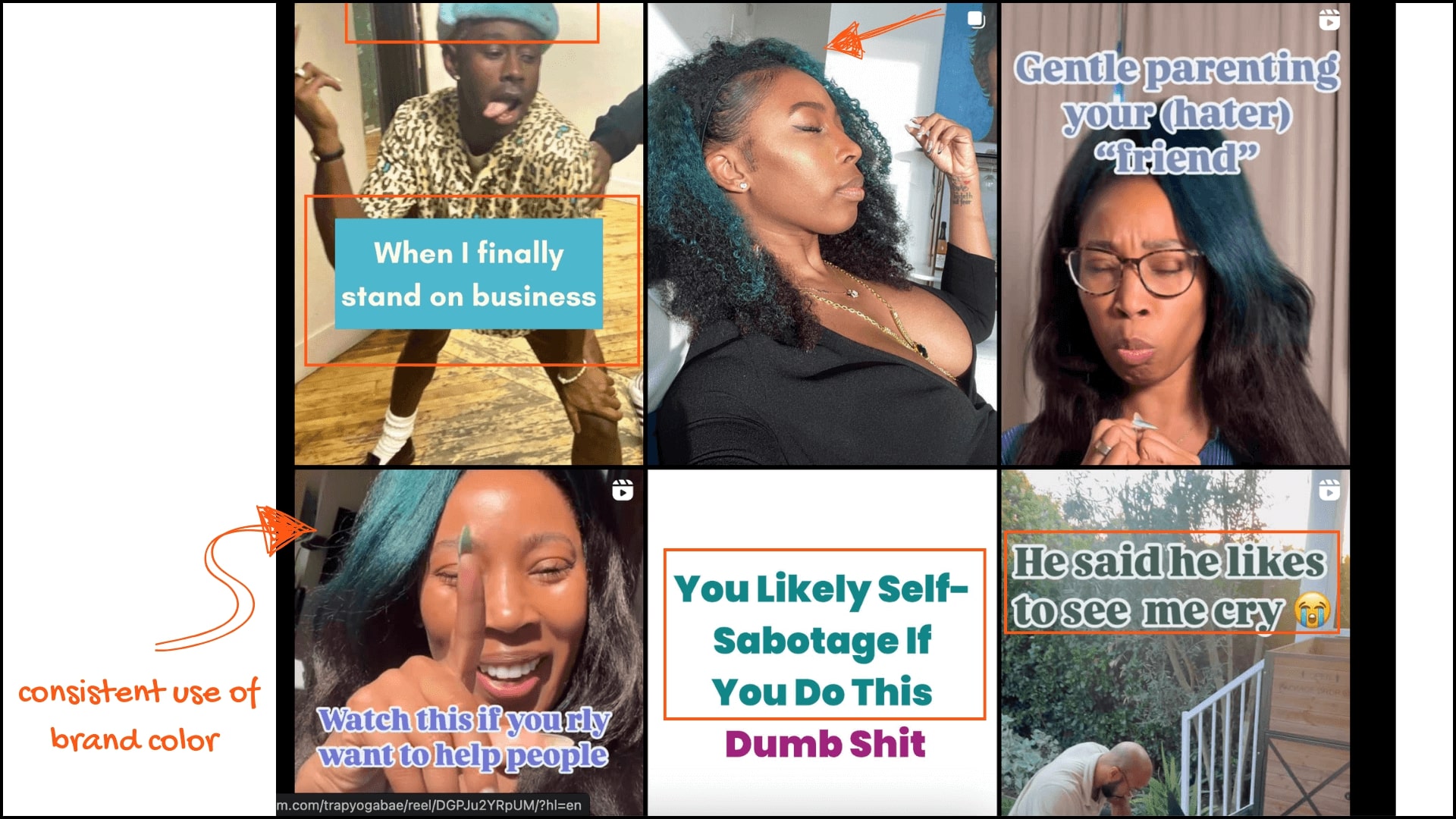
You may also want to update your channel’s pages, create sleek headers and thorough company descriptions, and make sure that all existing pages include your upcoming events.
Here are some quick tips for adding some glam to your profiles:
- Write an “about us” section to reflect your brand: Include a thorough, engaging description of your company. Use keywords that will help prospective attendees find your page, and include a mention of your event as well.
- Create a logo and brand slogan (and use it consistently): Make sure that your social media channels are consistent with one another. This includes usernames, URLs, headers, and descriptions.
For example, Nasstive Entertainment keeps things consistent by using the same profile icon across Instagram and Facebook, along with a clear tagline: “Bar crawls, club crawls, and special events.”
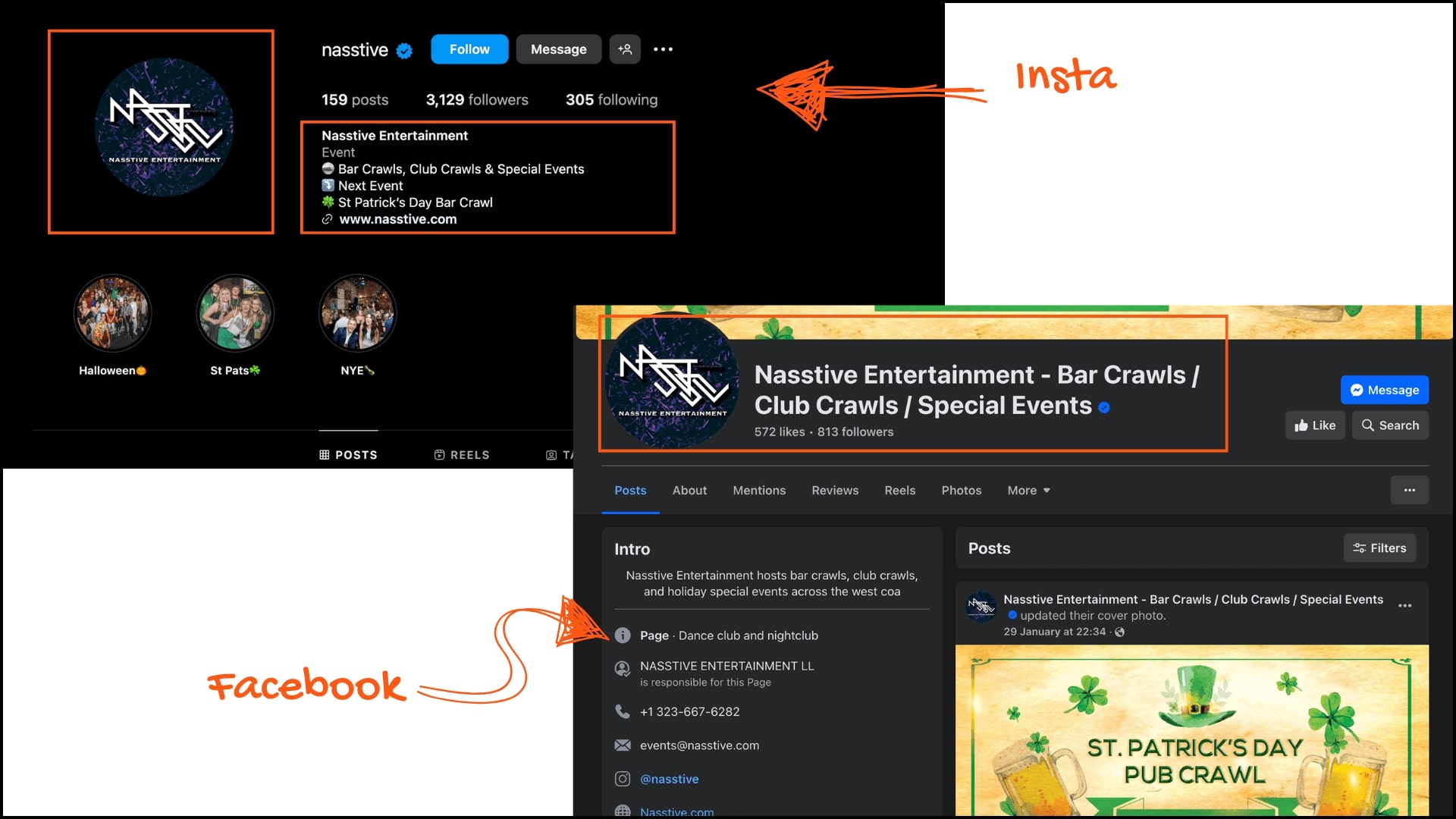
- Interlink your social media pages: On Facebook, include your Twitter handle and so on. This will allow fans to follow additional pages for news and updates.
- Go for the “clean look”: Don’t let your online presence look outdated when you’re using social media for events. Spruce up your virtual footprint with a Social Media Event Marketing Plan Template, which can help you build your own content calendar.
💡Pro tip: Make sure the image you use for your profile picture is the right size. Here are some guidelines for profile pictures on some of the most popular social media platforms:
- X: Profile pictures 400×400 pixels, header images 1500x1500 pixels.
- Facebook: Profile picture 170×170 pixels on desktop computers and 128×128 pixels on smartphones, cover photo 720 (w) pixels.
- Instagram: Profile picture 320x320 pixels
- LinkedIn profile photo: Profile picture 400×400 pixels, background image 1584 (w) x 396 (h) pixels.
3. Use a mix of popular and niche hashtags (that are relevant)
Ah, hashtags — the “will they or won’t they” of social media.
Some defend their honor to the death; meanwhile, Adam Mosseri (the head of Instagram) insists they don’t work.
Natasha was clear that hashtags are “definitely still a thing.” She said that you should absolutely be incorporating them into your marketing strategy (especially on TikTok and Instagram).
But not in the way you think.
Despite what we’ve been led to believe, hashtags are less about boosting reach and more about improving discoverability. Think of them like a filter for the algorithm. When you include a hashtag on a post, you’re helping TikTok and Insta determine what your content is about, where it should be placed on the platform and who it should be shown to.
That’s why Natasha recommends using “a mixture of popular and niche hashtags to increase your chances of discoverability.”
Here’s what else she suggests:
- Do your #research: When creating a hashtag, start by “typing keywords like “event” or a category that your event falls in and see what pops up. Different hashtag options will show up and show you how many posts are currently using that hashtag.”
From there, choose 1-2 “popular” hashtags (above 1k followers) and 1-2 more niche ones that relate specifically to your event. - Think like your audience: “If you’re struggling to create a hashtag, think like the consumer. If you were a consumer, what words would you use to search and find an event like yours?”
For instance, Kentucky Derby Festival includes hashtags specific to what type of event they’re promoting while also incorporating their branded "#DerbyFestivalMarathon."
- Keep it short and sweet: “If you're creating your own hashtag, you want to keep it short, simple, and easy to spell!" The longer and more complex your hashtag is, the higher the chance people will misspell it or avoid using it altogether — aim for one that’s easy to type on the go.
- Don’t go overboard: During one of his weekly “Ask Me Anything” sessions, Adam Mosseri revealed that cramming your posts with 50-100 hashtags doesn’t help you get discovered — what it does is get on people’s nerves. And Natasha agrees.
She says that while you shouldn’t be afraid of adding hashtags to every post, you don’t want to go overboard. It’s best to stick to around 3-5 relevant hashtags per post.
💡Pro tip: Anytime you post about your upcoming event, include your hashtag. Add it to all of your social account bios as well. And don’t stop there — promote your hashtag on all your other communication channels:
During the event, make sure your hashtag is visible so your attendees know to use it. Include it in handouts and display it on screens throughout your venue.
Better yet? Give potential attendees incentives to use your hashtag or share your event on social. This could mean setting up a photo booth branded with your hashtag or creating a photo competition where the best photo using your hashtag wins a prize.
4. Create #relatable content
Natasha stresses the importance of making your content relatable.
“People love to share content that resonates with them or reflects their experiences. Whether it’s funny, inspiring, or just downright heartwarming, make it something people can’t wait to share with their friends.”
An event organizer doing this very well is Eclectic Events.
Their profiles feature a mix of high-quality event photos, piece-to-camera interview-style content, memes, and behind-the-scenes footage. Every time they post, you'll see past event attendees commenting things like "can't wait to do this again" or "same" — they're engaging in what’s shared and showing genuine interest in what the brand is up to.
That’s the level of comfort you want to get with your audience.
Here are a few #relatable content ideas to get you started:
- On-the-ground interviews: Purchase a tiny microphone and host “vot-box” style interviews with attendees at your event.
In our TRNDS report 2025, Haroon Mota from Muslim Hikers shared how he promotes his hikes by interviewing attendees and showcasing the unique energy of the events. As he puts it, “… it’s not just posting an update — you want to show the real vibe of event day to showcase the real experience.” - Helpful tips, “life hacks” and “how to” tutorials: Share practical advice that adds value to your followers' everyday lives while subtly connecting back to your events.
For example, if you host cooking classes, start a recipe series on YouTube. If you're a nightlife venue, share tips on how to build the “perfect pumped up playlist” to play at your pre-party hangout. - Memes: Create relatable memes based on inside jokes and what's trending in your community. For example, set a TikTok dance trend (like the Doechii “Anxiety” trend) against the backdrop of something funny happening at your event.
💡Pro tip: Encourage attendees to send through live event photos to use on your social media and tag your accounts. That way, you can re-use their content as your content.
5. Get attendees “sharing” to increase engagement
For better or worse, how your posts are shown is determined by an algorithm that relies on one thing (and one thing only): data.
To the algorithm, it doesn't matter how many followers you have or who they are as individuals; what matters is how they interact with your content. The more likes, comments, and shares your posts receive, the more likely the algorithm is to push your content to others.
Ultimately, the algo’s job is to keep users on the platform by showing them content that keeps them hooked. Every piece of engagement you receive is a vote of confidence that your content can get the job done.
But it’s not just robots who crave validation — event attendees do, too.
In our TRNDS report 2025, we found that 80% of attendees are willing to pay more for tickets to events that are trending locally. Plus, 29% of organizers reported that attendees tend to spend more once they’re at the event.
These are some of Natasha’s fave engagement-boosting strategies:
- Contests and giveaways: One of the best ways to boost sharing when promoting social media for events is with a social media contest. Contests motivate word-of-mouth promotion without a huge investment. Try partnering with another local brand to give one of their products away in the contest.
For example, a yoga studio could give away a pack of classes and bath products companies could also contribute a basket of their products along with it. Then, both companies would make posts promoting the giveaway, and both would benefit from the dual exposure to each audience. - Discounts, deals, and packages: Offer limited-time promotions to create a sense of urgency and tap into potential attendees' “scarcity mindset.” For example, New Haven Nights offered an exclusive discount code to its social media followers while also emphasizing that "over 3,000 tickets have already sold" (well played, guys, well played).
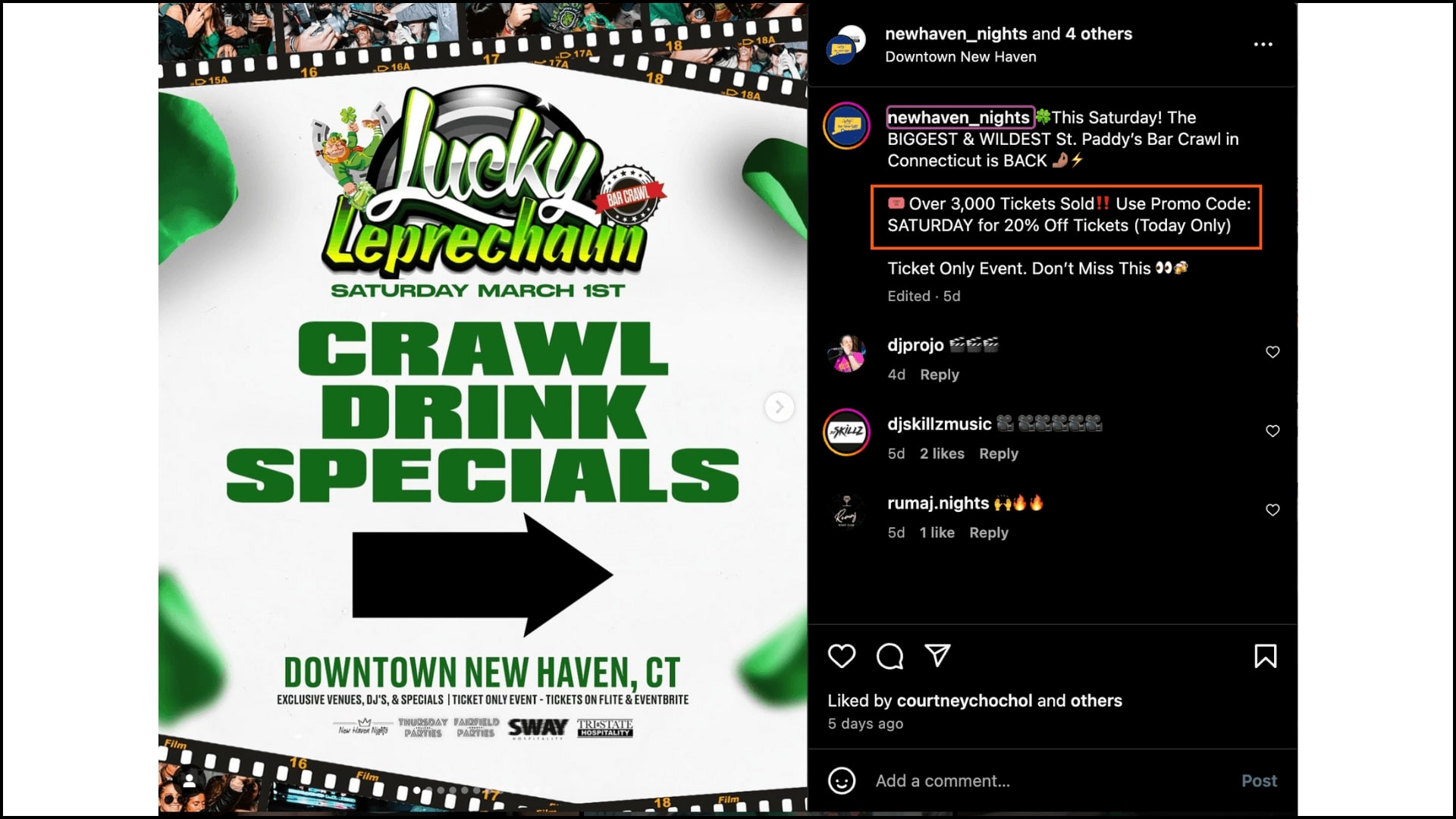
- Polls and quizzes: Create a poll or quiz using interactive features like Instagram Live Polls and Story question stickers. For instance, you could run a poll on potential event themes for your next gathering or ask for input on food and drink options so that your followers feel like they have a voice in shaping the experience.
💡Pro tip: Sophie suggests that if you’re running a contest, you should partner with other creators/brands to help it spread further. So, going back to our yoga studio example from before, they could do a class pack giveaway as a collab post with a bath products company giving away their items and a boutique offering their goods as well.
For example, for Pub Crawls' The Blossoms and Bubbles event, they partnered with it’sugar sweet shop to host a free treat giveaway for the first 100 people who used code “Union100.”
6. Partner with influencers to “hype up” your events
I know — everywhere you turn these days, it’s “influencer marketing this” or “influencer marketing that.” But honestly? That’s because it works.
Partnering with the right type of influencer not only helps you build excitement and FOMO around your event — it boosts your credibility.
The more trusted voices you have vouching for your event, the more interest you’ll receive. It’s like if multiple friends who love nightclubbing tell you there’s a new spot you just have to try. You’re going to go at least once, right?
And no, I’m not talking about macro- or mega-influencers with celebrity status (in terms of both followers and price). I mean the mighty micros (10,000–100,000 followers) and nano-influencers (1,000–10,000 followers) who’ve built small (but fiercely loyal) communities. We found out that 82% of consumers are highly likely to follow a recommendation from a micro-influencer.
According to Natasha, the key is keepin’ it real. Once you’ve found the right influencer, you want to create content that feels like an authentic recommendation, not a paid promotion.
Here’s what she recommends:
- Behind-the-scenes content: Allow influencers to come backstage before (or after) the show and share footage of the event set-up or interviews with the acts. “People love to take a peek behind the curtain and see someone’s experience before trying something out themselves!”
- Event previews: Organize a “sneak peek” where influencers get an exclusive first look at the event. For best results, time it with your ticket drop and give influencers a limited-time-only offer to share with their community.
- Live coverage: Invite influencers to come and take live footage of your event and then share it with their audience. In our TRNDS report 2025 Matt Orlove, from Orlove events shared how they “hired content creators to cover our events, so instead of having a standard videographer doing clips of the party, we had content creators who are active on TikTok and Instagram.”
For instance, micro-influencer Jordan Loufas shared a “day in the life” Instagram reel as she attended the 626 Night Market (sampling food, stalking the grounds — you know the drill).
And guess what? That video had an 18.05% engagement rate. If that doesn’t convince you that influencer marketing works — I don’t know what will.
- Event “takeovers”: Hand over the reins on your social posting to your influencer partner for a week leading up to the event. Takeovers work especially well if an influencer has a very distinct visual style, so if you’re planning a takeover, make sure you check their past content before finalizing the partnership.
- Exclusive discounts: Natasha suggests “partnering with influencers to offer their followers exclusive access, discounts, or giveaways related to the event to create a sense of exclusivity while encouraging engagement. For example, influencers can host a giveaway where the winner gets free tickets or VIP passes.”
💡Pro tip: Use a gifted product or a paid influencer campaign, where influencers receive free tickets or exclusive access to your event in exchange for coverage or a review.
This approach is cost-effective and can generate authentic engagement, as influencers are likely to share their genuine experiences with their followers.
But, keep in mind that paid influencer campaigns (where they get money as opposed to gifts) can give you more control over what the influencer says, ensuring they deliver the message you want to send. While it’s more expensive for you, the results are usually better. Paid influencers can help you reach larger audiences and higher-profile influencers.
| Influencer tier | Follower range | Example compensation for event collaboration |
| Nano influencer (local/niche audience) | 1k-10k | Free event access + drink/food vouchers + $50-$300 or product trade |
| Micro influencer (engaged, but small community) | 10k-100k | $300 - $1,500 payment + VIP access + affiliate commission |
| Mid-Tier influencer (strong influence) | 100k-250k | $1,500 - $5,000 payment + travel stipend + branded content collab |
| Macro influencer (high visibility) | 250k-1M | $5,000 - $15,000 + full event experience + hosted meet & greet |
| Mega influencer (celebrity status) | 1M+ | $15,000+ payment + all-inclusive travel + exclusive event partnership |
7. Build (and sell tickets through) a great event page
We all know that having a good event page is a key part of promoting your event on platforms like Facebook Events.
But, how do you build one that grabs attention and delivers essential information in a clear, compelling way?
Here are a few tips for making your page as effective as possible:
- Choose a cover photo that looks good on any size screen
- Be specific about location, time, and category so the platform can help promote your event
- Craft a compelling event description — make it brief and clear, using bullet points to communicate key information as efficiently as possible.
- Put your ticketing link front and center
If you want to see a Facebook event page done right, take a look at Life Thrive Yoga’s Facebook event page, for their upcoming Radiant Fires: A One Day Yoga Retreat Event.
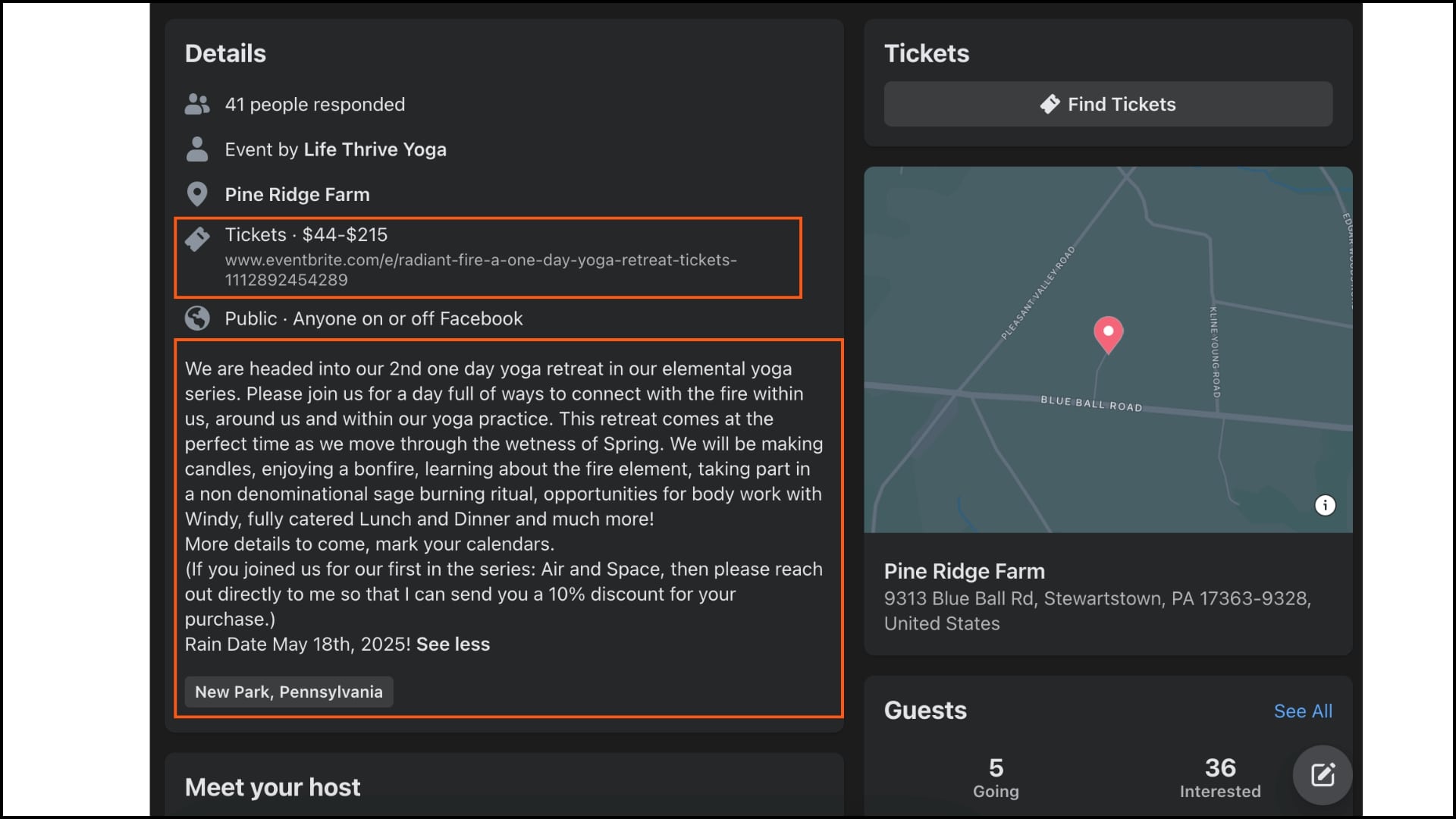
What makes this event page great:
- Mention of an exclusive offer: The "10% discount" for returning attendees from the "Air and Space" event creates a sense of loyalty and rewards previous participants.
- Use of emotive language: Phrases like "connect with the fire within us" signal from the get go that this is a mindful, transformative experience for yoga practitioners seeking spiritual connection (aka, the target audience).
- Clear outline of details: All essential information (location, price, date, activities) is clearly presented in a way that makes it easy for potential attendees to quickly understand what the event offers.
💡Pro tip: You can sell your tickets on Facebook with Eventbrite as your processor by using our “Add to Facebook feature.” In fact, events that sell tickets directly on Facebook double the number of free registrations and increase ticket purchases by about 20% compared to events that redirect to a ticketing page.
Here’s how you do it:
1. Log in and select your event
2. Select Marketing, and then Add to Facebook
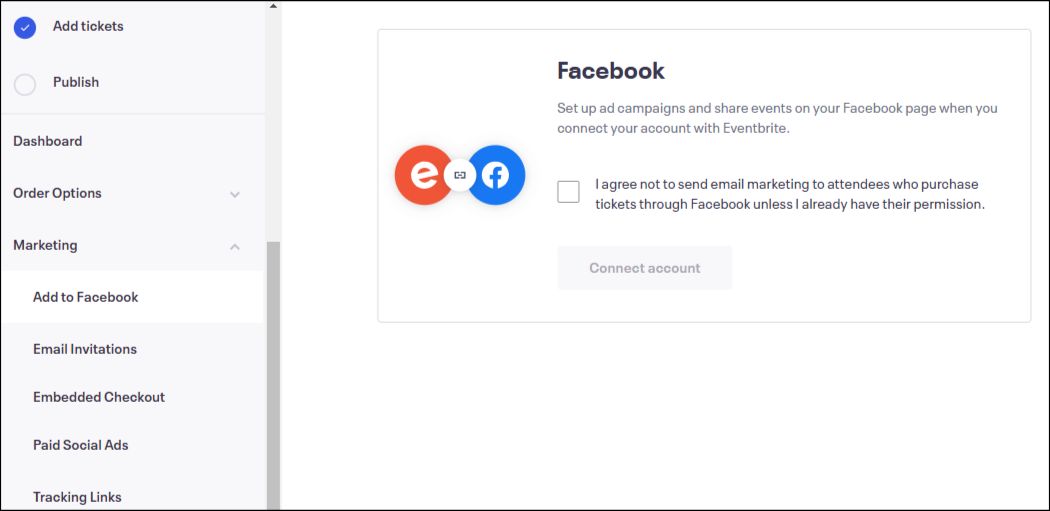
3. Agree to the terms and conditions
4. Select Connect Account
5. Log into your Facebook account and choose your Facebook page from the drop-down
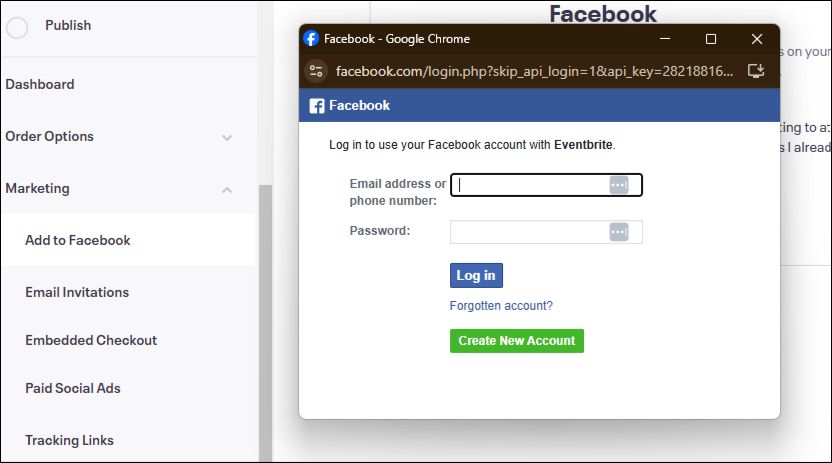
6. Review the event description and make any necessary changes
7. Select Publish on Facebook and you’re done!
Sell more tickets with Facebook and Eventbrite
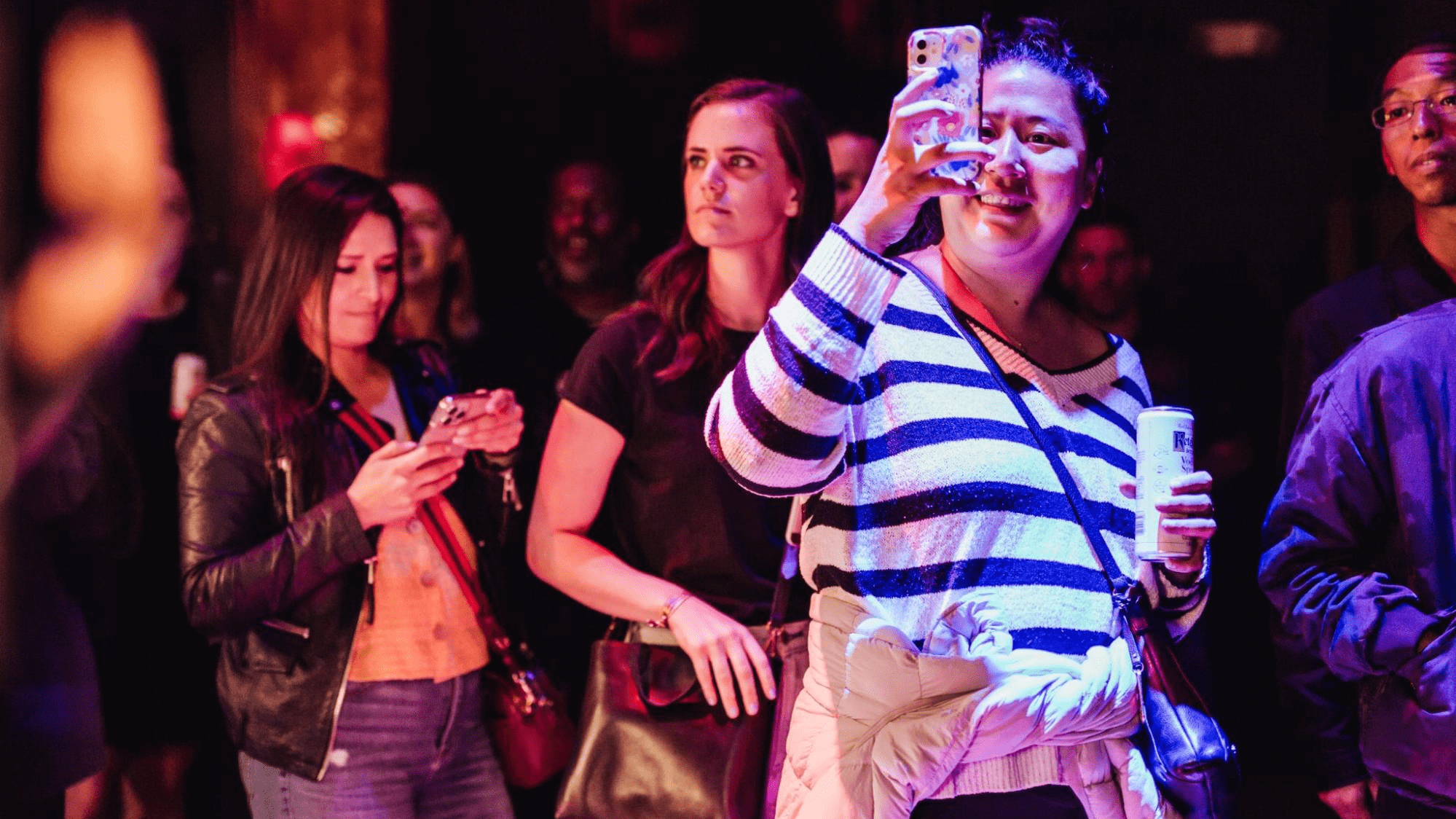
8. Target your people with paid social media ads
If you want to get your content in front of the right people, you’ve got to pay-to-play. It’s that simple.
Luckily for us, in 2025, there’s no shortage of options when it comes to creating paid social ads. On Facebook, you can run dynamic ads, Instagram offers interactive formats like Stories ads and Reels ads, and LinkedIn and X provide a “sponsored content” option.
No matter which one you choose, here’s the philosophy I want you to live by: “I will create clear, concise and click-worthy ads.”
To do that, include:
- An eye-catching image or video
- Short and sweet post-text
- An even shorter headline — that’s still engaging
- A direct call to action (e.g., “Buy Tickets”)
- An accurate link description (e.g., “Click here to buy tickets”)
- A brief text overlay at the very beginning explaining what the audience is about to watch, like “3 Upcoming Events at The Sill”
Use Eventbrite’s Marketing tools to run efficient ad campaigns
With Eventbrite's marketing tools, you can create social media ads that actually drive ticket sales. And the best part? The process is simple — so simple, in fact, that we've broken it down into four easy steps.
First, we help you customize your strategy, including setting up your campaign goal. Then, we guide you through entering the basic details of your event. Next, we help you set up your ad campaign, such as segmenting your audience. Finally, together, we launch that campaign into the world.
The reason why this process is so simple (but effective) is because we’ve worked with event organizers around the globe to refine and optimize it. In fact, Eventbrite Ads campaigns now achieve a 30% better click-through rate (CTR) than Facebook Ads.
This is how we make it happen:
- Smart audience targeting: Create custom audience segments based on your audience's interests, location, and past ticket buyers, ensuring you're reaching the people most likely to attend your event.
- A/B split testing: Allows you to test different ad creatives and formats (such as images vs. videos, or single-image vs. carousel ads) to determine which one gets the best response from your audience.
- Data-driven insights: Send you real-time performance with metrics like ticket sales, engagement, and ad reach, and recommendations on how to tweak your ads and daily budget spend to reach your specific campaign goals.
Here’s how you go about setting up your Ad campaign:
1. Login and go to Marketing Tools.
2. Select Paid Social Media Ads.
3. Review the strategy and select Ad Campaigns.
4. Select Create a new campaign.
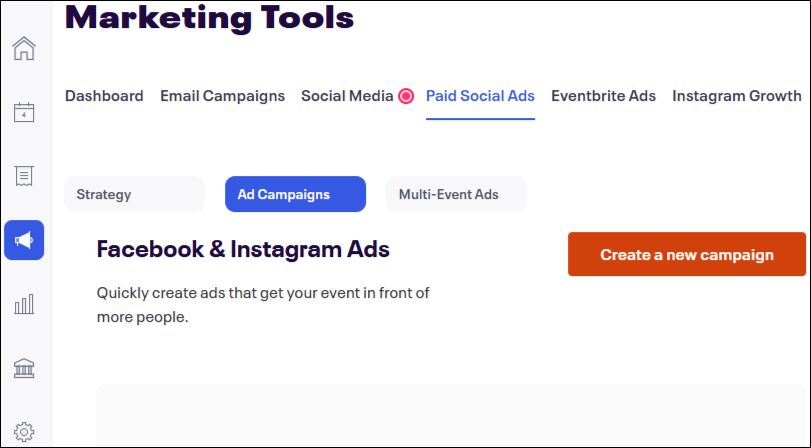
5. Review specifics of your campaign like audiences, design, and descriptions to set up your campaign.
Build better ads with Eventbrite

💡Pro tip: Take a look at the guide that Sam put together on how to build your first ad campaign. He runs through the whole process, from how to choose your objective based on your campaign goals, to modifying your audience and setting your ad budget spend.
9. Use live video to build FOMO
When we talk about social media event marketing, there's a lot of focus put on the "before and after” of it all. But, using social media during your events is how you truly tap into FOMO.
Why? Because FOMO hits hardest when people feel like they're missing out on something happening in that moment. The best way to show potential attendees what they're missing is to put them right in the middle of the action with live video.
Here's why it works:
- Attendees want to tune in: The demand for live streaming is on the rise folks. Twitch was averaging 2.5 million concurrent viewers in 2024 and when we asked attendees back in 2023, nearly 50% of survey respondents said they’d still like to tune into an event even if they’re unable to travel and be there physically.
- It’s low-cost and low-effort (but high reward): You don’t have to livestream your entire event to cash in on the rewards. Using short, live clips from your event, like behind-the-scenes peeks or interviews with performers is enough to keep viewers engaged and give them a taste of the action.
- Creates a “communal experience”: Live-streaming gives attendees a taste of how it feels to be part of your community. The more connected they feel, the more likely they are to buy tickets next time.
In fact, we found that 22% of event attendees crave the interaction provided by live-streaming. The best way to maximize this connection is by encouraging active participation. You can use interactive features like Facebook live polls or Q&As to engage viewers in real time and boost involvement by responding to comments.
For example, when I watched Independent Harold’s live stream of the Scott County Fair Association event, I found myself “love-heart-reacting” to comments and shouting “yes!” at other people’s quips. That back-and-forth made me want to buy tickets to experience the crowd in person next time.
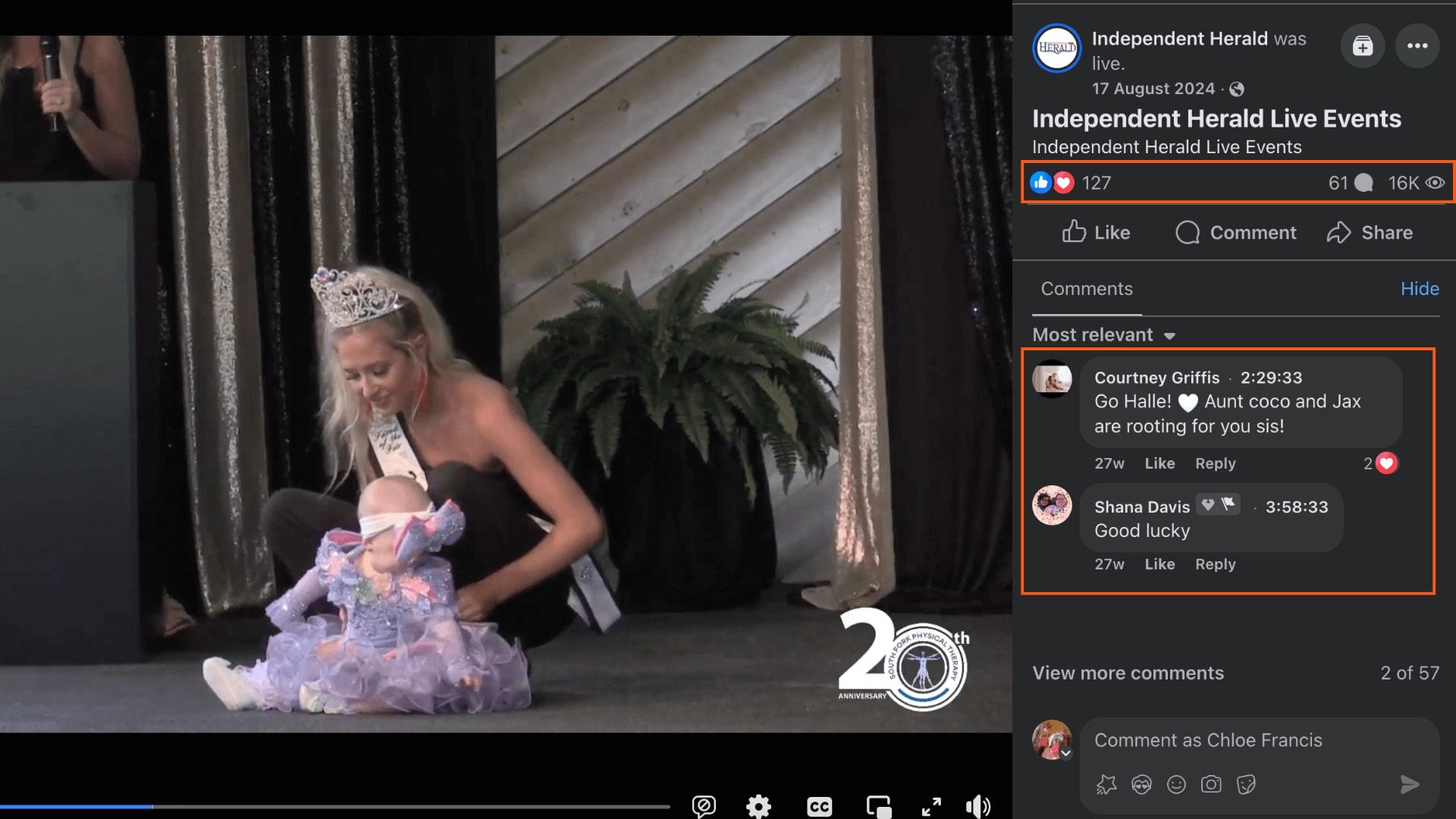
By now, I bet you’re wondering “how do I get myself one of these live video sessions?”
Well, you can set up a stream directly through a platform like Facebook Live or YouTube. Or, you can save yourself a ton of time and hassle, and create a livestream on Eventbrite.
Here’s a quick walkthrough on how to do that:
💡Pro tip: To ensure your streams find an audience, make sure your livestreams are longer than 10 minutes (longer streams have a better chance of attracting more users).
10. Track, test, and tweak your strategy using data insights
I'm going to be honest with y'all right now. The strategies I've shared in this article are just a guide. Because without looking at your data, I have no idea what's going to work for your event community specifically (if someone tells you they can, run).
But, there is a way to find out. Natasha says the best place to start is by establishing clear and measurable goals for what “success” looks like for you.
“Whether you’re aiming to increase website traffic, boost brand awareness, or drive sales, setting goals helps you define what success looks like and provides benchmarks for tracking success.”
From there, pull together your social media analytics from every platform you’re posting on. I’d recommend going as far back as 12 months (if you can).
These are the four metrics Natasha wants you to pay attention to:
Natasha explained that “these metrics help you assess the visibility of your content and how effectively you’re reaching a broader audience… a wider reach paired with high impressions often suggests that your content is being shared or discovered outside of your immediate followers.”
- Engagement metrics: Natasha says, “focus on likes, comments, shares, and saves to gauge how well your audience is interacting with your content. High engagement is a strong indicator that your posts are resonating with followers, while low engagement can suggest areas for improvement.”
- Follower growth and engagement: Natasha advises that you want to pay attention to how your follower list is performing over time.
“A steady increase in followers typically signals that your content is attracting new people and that your social media strategy is working. However, look beyond just the numbers — engagement with your new followers is just as important for building lasting relationships.”
To keep track of your engagement rates, Natasha suggests using a social media marketing tool, like Hootsuite.
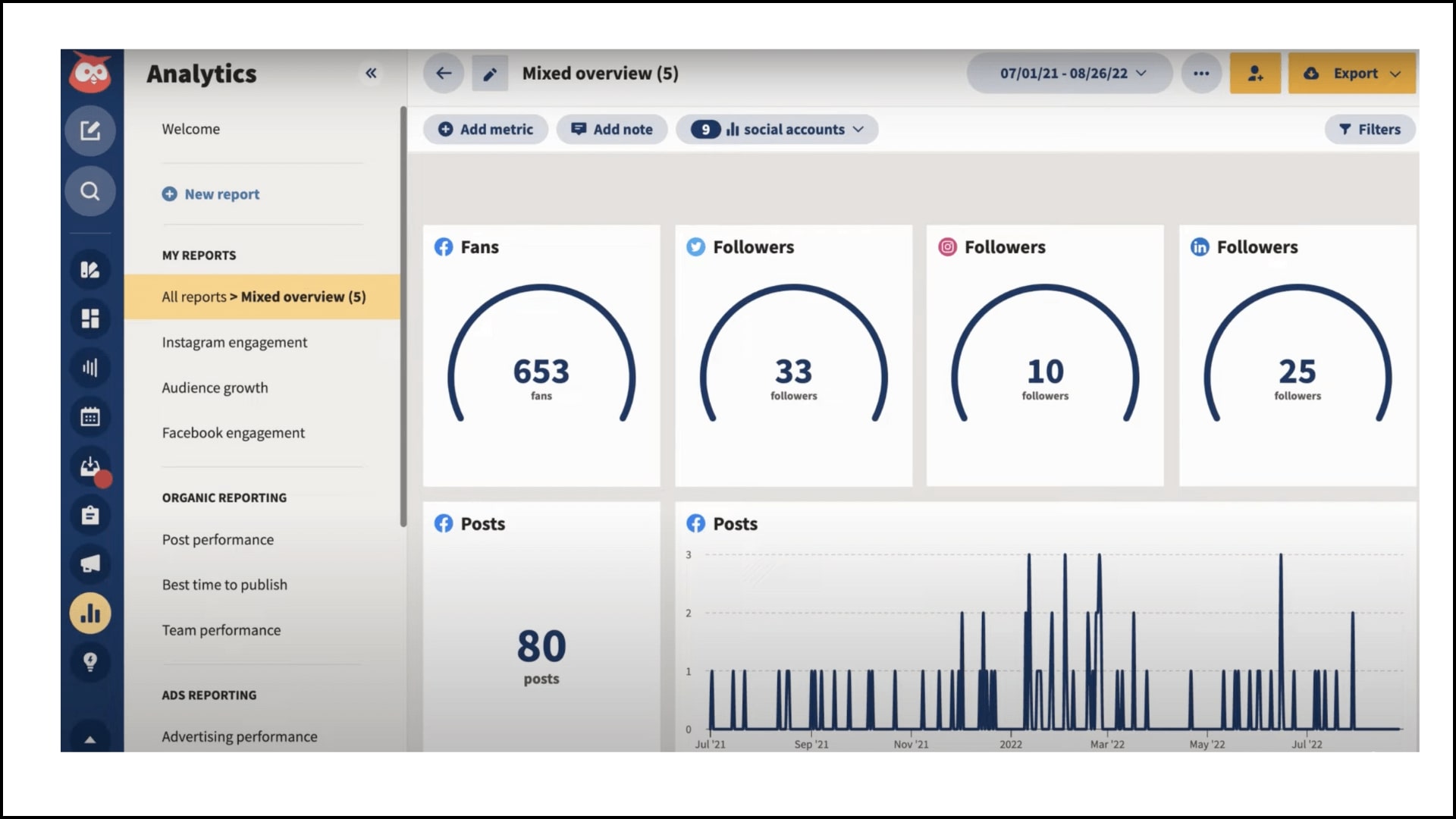
- Reach and impressions: If engagement is about how your audience interacts with your content, then reach and impressions are about how far your content is traveling.
Natasha explained that “these metrics help you assess the visibility of your content and how effectively you’re reaching a broader audience… a wider reach paired with high impressions often suggests that your content is being shared or discovered outside of your immediate followers.” - Audience analytics: Sophie recommends checking audience demographics in platform analytics like Instagram Insights or Twitter Analytics. Natasha agrees, emphasizing that tracking trends, peak posting times, and audience data helps you refine your approach.
Her advice? Use built-in analytics or invest in a tool like Sprout Social to compare performance across platforms and better understand audience engagement.
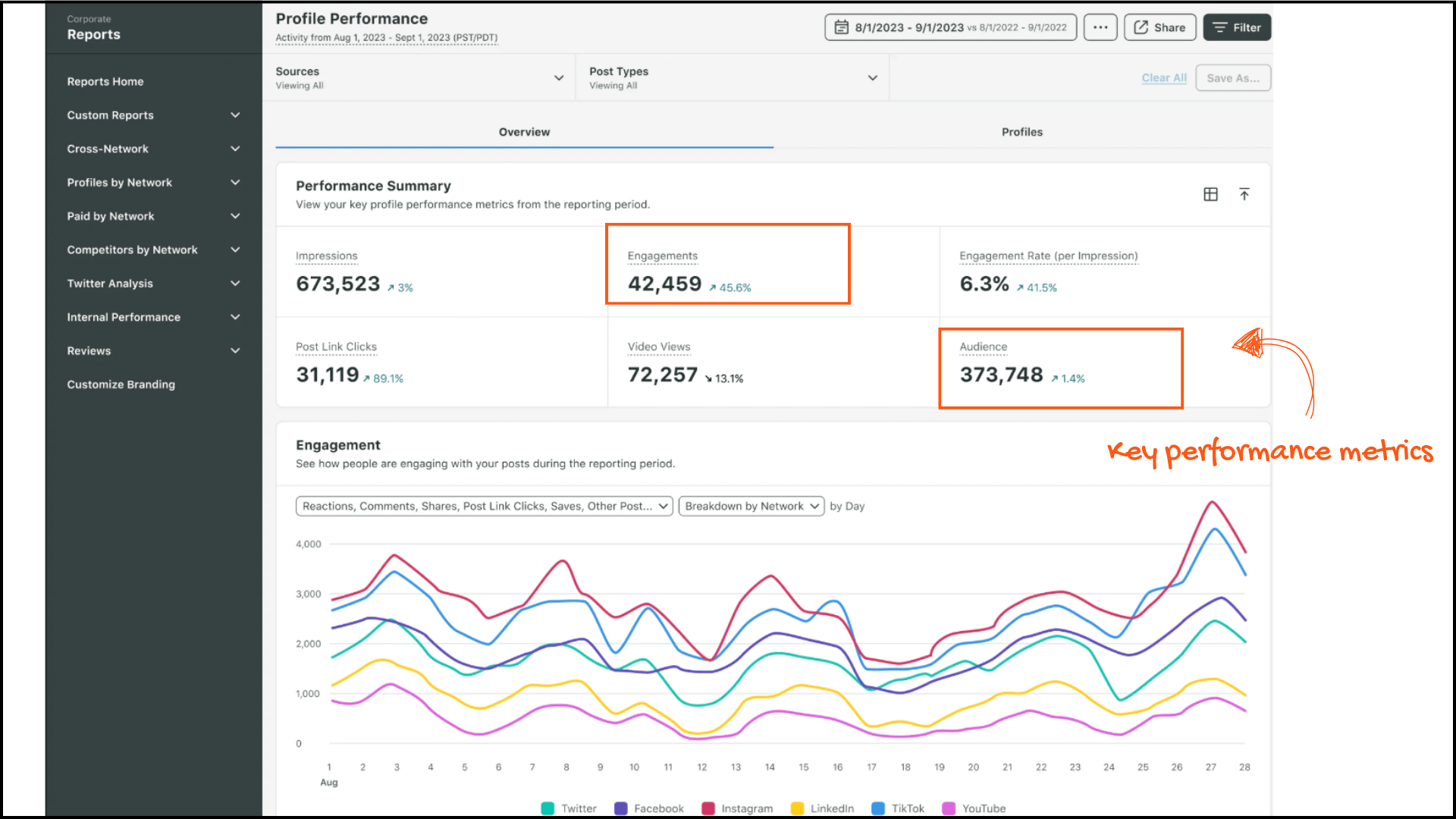
💡Pro tip: With Eventbrite, you can create custom tracking links and embed Facebook tracking pixels on different parts of your sales funnel to pinpoint exactly where your ticket sales are coming from (and where potential attendees are dropping off).
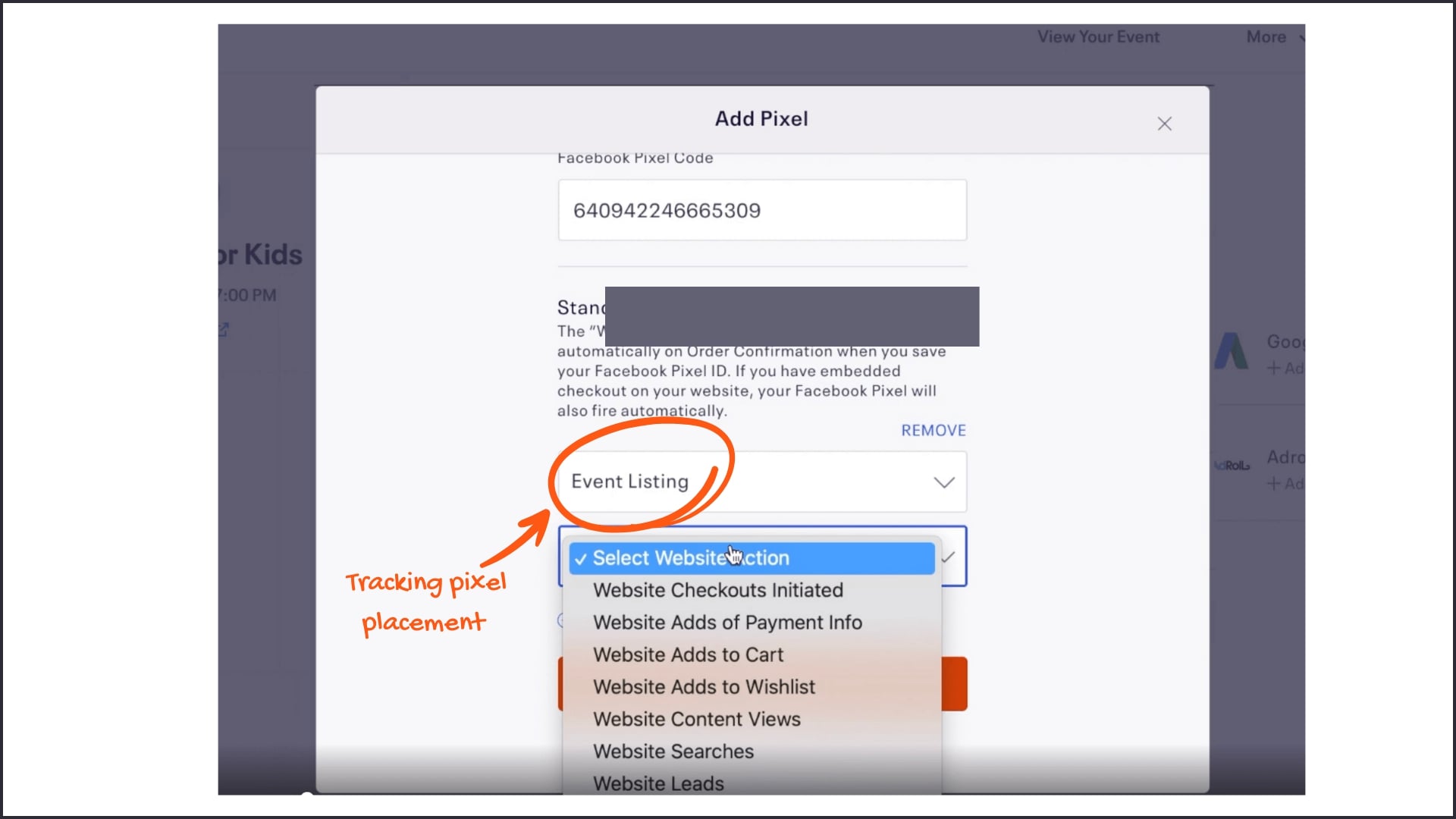
For instance, if someone clicks on your ad, lands on your event page, but then abandons their cart, it could mean there’s a disconnect between your ad messaging and your event itself. To fix this, you could try A/B testing — tweak the copywriting on your ad, update the images, and optimize your event page to see what works.
Want a full walkthrough? Check out the video below.
You’ve got this.
If you’re at the point with your social media marketing where all you’re getting is a handful of impressions here and a couple of clicks there, I just want you to know — it’s okay.
Social media event promotion is hard and (despite what people say) it takes a LOT more than posting to get likes, comments and shares. Real marketing takes time, strategy and hours of testing.
But here’s the good news: you’ve got a plan now that’s built to work. So, here’s my recommendation: make the most of it.
Take Natasha’s advice: “… don’t forget to keep it entertaining and thought-provoking — those are the posts people will want to share with others.” Develop a social voice that reflects your brand personality, and for the love of all event-gods, partner with an influencer already (seriously, do it).
And don’t forget — you don’t have to do social media event marketing alone. We’re on your side. From TikTok promotion to embedding your checkout on Instagram, and optimizing your Facebook event page, we can help you fine-tune every stage of your social strategy so that it actually delivers the results you’re looking for.
